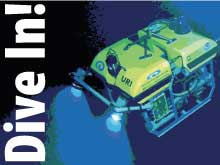
These lesson plans focus on the North Atlantic Stepping Stones 2005 Cruise.
Education
The National Oceanic and Atmospheric Administration (NOAA) has a great opportunity to reach out in new ways to teachers, students, and the general public through its ocean exploration efforts and share the excitement of daily at-sea discoveries and the science behind its major ocean exploration initiatives with the people around the world. The North Atlantic Stepping Stones 2005 Expedition presents a unique opportunity to engage explorers of all ages as we journey to a world that few have seen. In the North Atlantic Ocean, the New England and Corner Rise Seamounts are part of a volcanic chain that extends from Canada to the African tectonic plate. Scientists are interested in discovering if these seamounts function as "stepping stones;" allowing hard substrate organisms, like deep-sea corals; to disperse among these deep-sea "islands" and expand their ranges across the Atlantic Ocean Basin. The scientists on board the expedition hope to develop a more complete understanding of patterns in the diversity and abundance of corals associated with these seamounts, the species that live in association with them, and deep-sea nekton of the seamount habitats in the western North Atlantic in an attempt to answer the "stepping stones" question.
Many of the seamounts that will be explored on this expedition have never been biologically sampled by submersible or remotely operated vehicles before, and the science team will be using the Hercules/Argus ROV system as the primary sampling tool to obtain high resolution imagery and discrete faunal samples from particular sites. Multibeam sonar will be used to aid in dive planning and to better understand variation in seamount morphologies and landscape patterns. These remotely-operated dives will provide seafloor samples and observations from critically important sites to assess the role of the New England and Corner Rise Seamounts in controlling the biogeography, diversity, and evolution of deep-water corals and other fauna in the North Atlantic.
Educators and scientists working with NOAA during July 2005 developed a series of inquiry- and National Science Education Standards-based lesson plans for students in Grades 5-12 that are specifically tied to the North Atlantic Stepping Stones 2005 Expedition. These lesson plans focus on cutting-edge ocean exploration and research using state-of-the-art technologies. Lessons focus on symbiotic relationships in corals, paleoclimatology, and the impacts of climate change on biological communities of the deep ocean.The lesson plans are grouped into the following categories:
Grades 5-6
Grades 7-8
Grades 9-12 (Chemical, Biological, Earth, and Physical Science)
Each grade-level grouping includes an activity that focuses on the exploration and research being conducted as part of the North Atlantic Stepping Stones 2005 Expedition. In addition to being tied to the National Science Education Standards, the hands-on, inquiry-based activities include focus questions, background information for teachers, links to interesting Internet sites, and extensions. Web logs that document the latest discoveries and complement the lesson plans, complete with compelling images and video, will be sent back each day from sea. Teachers are encouraged to use the daily logs from the North Atlantic Stepping Stones 2005 Expedition, which are posted on this site, to supplement the lesson plans.
Read a description of each lesson plan and/or download them to your computer. All of the lesson plans are available in PDF format, and may be viewed and printed with the free Adobe Acrobat Reader ![]() . To download a lesson plan, click on its title from the listing below.
. To download a lesson plan, click on its title from the listing below.
Grade Level 5-6
Friend, Foe, or . . . (5 pages, 331k)
Focus (Life Science) - Symbiotic relationships with corals
In this activity, students will be able to define and describe symbiotic, mutualistic, commensal, parasitic, facultative and obligatory relationships between organisms; describe at least three species that have symbiotic relationships with corals; and discuss whether these relationships are mutualistic, commensal, or parasitic.
Grade Level 7-8
Climate, Corals, and Change (14 pages, 441k)
Focus (Physical Science) - Paleoclimatology
In this activity, students will be able to explain the concept of "paleoclimatological proxies" and describe at least two examples, describe how oxygen isotope ratios are related to water temperature, and interpret data on oxygen isotope ratios to make inferences about the growth rate of deep-sea corals. Students will also be able to define "forcing factor" and will be able to describe at least three forcing factors for climate change and discuss at least three potential consequences of a warmer world climate.
Grade Level 9-12
Top to Bottom (7 pages, 348k)
Focus (Earth Science/Life Science) - Impacts of climate change on biological communities of the deep ocean
In this activity, students will be able to describe thermohaline circulation, explain how climate change might affect thermohaline circulation, and identify the time scale over which such effects might take place. Students will also be able to explain how warmer temperatures might affect wind-driven surface currents and how these effects might impact biological communities of the deep ocean, and discuss at least three potential impacts on biological communities that might result from carbon dioxide sequestration in the deep ocean.
























